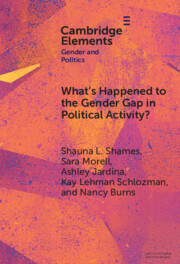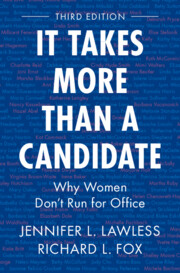Refine search
Actions for selected content:
56 results
Allies on the streets but illiberal in the sheets? Gender and the public vs. private inclusion of sexual minorities
-
- Journal:
- European Journal of Political Research ,
- Published online by Cambridge University Press:
- 30 September 2025, pp. 1-27
-
- Article
-
- You have access
- Open access
- HTML
- Export citation
9 - Chile’s PTA Services Impact Assessment Looking beyond Trade Flows
-
-
- Book:
- Globalization in Latin America
- Published online:
- 09 June 2025
- Print publication:
- 26 June 2025, pp 178-208
-
- Chapter
-
- You have access
- Open access
- HTML
- Export citation
Do Men and Women Differ in their Political Knowledge about Policy Responsibilities across Levels of Government?
-
- Journal:
- Canadian Journal of Political Science/Revue canadienne de science politique / Volume 58 / Issue 3 / September 2025
- Published online by Cambridge University Press:
- 20 June 2025, pp. 716-729
-
- Article
-
- You have access
- Open access
- HTML
- Export citation
Gender Vote Gaps Among Ethnic Minority Voters in Britain
-
- Journal:
- British Journal of Political Science / Volume 55 / 2025
- Published online by Cambridge University Press:
- 14 May 2025, e73
-
- Article
-
- You have access
- Open access
- HTML
- Export citation
Support for the MAGA Agenda: Race, Gender, and Authoritarianism
-
- Journal:
- Journal of Race, Ethnicity and Politics / Volume 10 / Issue 1 / March 2025
- Published online by Cambridge University Press:
- 20 March 2025, pp. 221-240
-
- Article
-
- You have access
- Open access
- HTML
- Export citation
Cancelling out early age gender differences in competition: an analysis of policy interventions
-
- Journal:
- Experimental Economics / Volume 19 / Issue 2 / June 2016
- Published online by Cambridge University Press:
- 14 March 2025, pp. 412-432
-
- Article
- Export citation

What's Happened to the Gender Gap in Political Activity?
- Social Structure, Politics, and Participation in the United States
-
- Published online:
- 13 March 2025
- Print publication:
- 13 March 2025
-
- Element
-
- You have access
- Open access
- HTML
- Export citation
2 - Gender and Candidate Emergence
-
- Book:
- It Takes More Than a Candidate
- Published online:
- 28 February 2025
- Print publication:
- 06 March 2025, pp 14-26
-
- Chapter
- Export citation
3 - The Gender Gap in Political Ambition
-
- Book:
- It Takes More Than a Candidate
- Published online:
- 28 February 2025
- Print publication:
- 06 March 2025, pp 27-39
-
- Chapter
- Export citation
6 - Gendered Self-Perceptions of Candidate Viability
-
- Book:
- It Takes More Than a Candidate
- Published online:
- 28 February 2025
- Print publication:
- 06 March 2025, pp 79-99
-
- Chapter
- Export citation
4 - Family Dynamics and Running for Office
-
- Book:
- It Takes More Than a Candidate
- Published online:
- 28 February 2025
- Print publication:
- 06 March 2025, pp 40-60
-
- Chapter
- Export citation
8 - The Persistent Gender Gap in Political Ambition
-
- Book:
- It Takes More Than a Candidate
- Published online:
- 28 February 2025
- Print publication:
- 06 March 2025, pp 116-128
-
- Chapter
- Export citation
1 - Still a Man’s World?
-
- Book:
- It Takes More Than a Candidate
- Published online:
- 28 February 2025
- Print publication:
- 06 March 2025, pp 1-13
-
- Chapter
- Export citation
5 - Gender, Party, and Political Recruitment
-
- Book:
- It Takes More Than a Candidate
- Published online:
- 28 February 2025
- Print publication:
- 06 March 2025, pp 61-78
-
- Chapter
- Export citation
7 - Taking the Plunge
-
- Book:
- It Takes More Than a Candidate
- Published online:
- 28 February 2025
- Print publication:
- 06 March 2025, pp 100-115
-
- Chapter
- Export citation

It Takes More Than a Candidate
- Why Women Don't Run for Office
-
- Published online:
- 28 February 2025
- Print publication:
- 06 March 2025
A Look Back At 20 Years of Research on Gender and Voting in Politics & Gender
-
- Journal:
- Politics & Gender / Volume 21 / Issue 1 / March 2025
- Published online by Cambridge University Press:
- 08 January 2025, pp. 51-65
-
- Article
-
- You have access
- Open access
- HTML
- Export citation
Disentangling the gender-differentiated determinants of home-based self-employment choices in Nigeria
-
- Journal:
- The Economic and Labour Relations Review / Volume 35 / Issue 4 / December 2024
- Published online by Cambridge University Press:
- 08 November 2024, pp. 905-938
-
- Article
-
- You have access
- Open access
- HTML
- Export citation
Bullying at work: Differential pattern in Euro-Area according to gender-based disparities
-
- Journal:
- The Economic and Labour Relations Review / Volume 35 / Issue 2 / June 2024
- Published online by Cambridge University Press:
- 06 September 2024, pp. 319-344
-
- Article
- Export citation
How Gap Measures Determine Results: The Case of Proportional Systems and the Gender Mobilization Gap
-
- Journal:
- British Journal of Political Science / Volume 54 / Issue 4 / October 2024
- Published online by Cambridge University Press:
- 30 April 2024, pp. 1468-1476
-
- Article
-
- You have access
- Open access
- HTML
- Export citation
